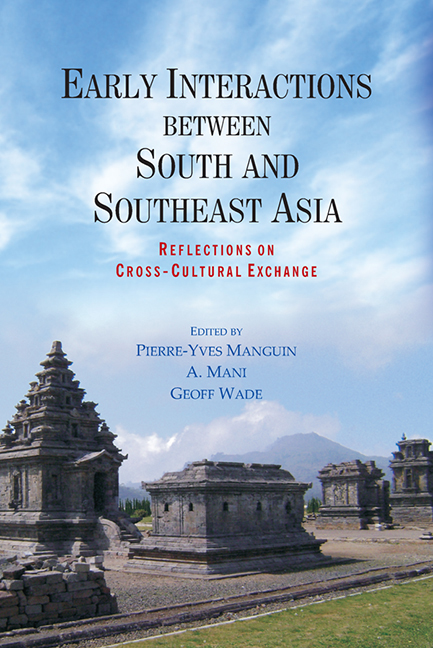Book contents
- Frontmatter
- Contents
- FOREWORD
- Preface
- Introduction
- PART I New Archaeological Evidence from South Asia and Southeast Asia
- PART II Localisation in Southeast Asia
- 11 Tamil Merchants and the Hindu-Buddhist Diaspora in Early Southeast Asia
- 12 The Spread of Sanskrit in Southeast Asia
- 13 The Early Inscriptions of Indonesia and the Problem of the Sanskrit Cosmopolis
- 14 Indian Architecture in the ‘Sanskrit Cosmopolis’: The Temples of the Dieng Plateau
- 15 The Importance of Gupta-period Sculpture in Southeast Asian Art History
- 16 Individuals under the Glaze: Local Transformations of Indianisation in the Decorative Lintels of Angkor
- 17 Early Musical Exchange between India and Southeast Asia
- 18 Buddhism and the Circulation of Ritual in Early Peninsular Southeast Asia
- 19 Early Buddhism in Myanmar: Ye Dhammā Inscriptions from Arakan
- 20 Hindu Deities in Southern Vietnam: Images on Small Archaeological Artefacts
- 21 ‘The Depositing of the Embryo’ – Temple Consecration Rituals in the Hindu Tradition of South and Southeast Asia: A Study of the Textual and Archaeological Evidence
- 22 Localisation of Indian Infl uences as Refl ected in the Laotian Versions of the Ramayana
- 23 Broken Threads: Contested Histories of Brahminism in Cambodia and Thailand and the Construction of Ritual Authority
- LIST OF CONTRIBUTORS
- INDEX
11 - Tamil Merchants and the Hindu-Buddhist Diaspora in Early Southeast Asia
from PART II - Localisation in Southeast Asia
Published online by Cambridge University Press: 21 October 2015
- Frontmatter
- Contents
- FOREWORD
- Preface
- Introduction
- PART I New Archaeological Evidence from South Asia and Southeast Asia
- PART II Localisation in Southeast Asia
- 11 Tamil Merchants and the Hindu-Buddhist Diaspora in Early Southeast Asia
- 12 The Spread of Sanskrit in Southeast Asia
- 13 The Early Inscriptions of Indonesia and the Problem of the Sanskrit Cosmopolis
- 14 Indian Architecture in the ‘Sanskrit Cosmopolis’: The Temples of the Dieng Plateau
- 15 The Importance of Gupta-period Sculpture in Southeast Asian Art History
- 16 Individuals under the Glaze: Local Transformations of Indianisation in the Decorative Lintels of Angkor
- 17 Early Musical Exchange between India and Southeast Asia
- 18 Buddhism and the Circulation of Ritual in Early Peninsular Southeast Asia
- 19 Early Buddhism in Myanmar: Ye Dhammā Inscriptions from Arakan
- 20 Hindu Deities in Southern Vietnam: Images on Small Archaeological Artefacts
- 21 ‘The Depositing of the Embryo’ – Temple Consecration Rituals in the Hindu Tradition of South and Southeast Asia: A Study of the Textual and Archaeological Evidence
- 22 Localisation of Indian Infl uences as Refl ected in the Laotian Versions of the Ramayana
- 23 Broken Threads: Contested Histories of Brahminism in Cambodia and Thailand and the Construction of Ritual Authority
- LIST OF CONTRIBUTORS
- INDEX
Summary
It is generally accepted that the dissemination of Hindu-Buddhist beliefs and ritual practises in first millennium Southeast Asia were largely the result of initiatives of local rulers to recruit Brahman priests and Buddhist monks able to secure their political and personal welfare. Yet it remains equally selfevident that the medium of transmission of both an awareness of Indian culture, and of its agents and propagators, were the merchant vessels which linked the Indian Ocean diaspora. It follows that a study of early traces of Indian merchant activity in the region should provide clues to the early entry of Indic religious systems into the emerging states and kingdoms of Southeast Asia.
The legacy of these early contacts and engagements are indicated by the scattering of Indic script stone stele inscriptions, both royal and mercantile, and by the regional distribution of the earliest Indic religious imagery, imported and locally produced. The vast majority of the inscriptions identify the patron, usually a local ruler who had assumed the trappings of Hindu culture, often including obeisance to Shiva or Vishnu and a Sanskritised honorific title and name-form. Religious imagery is, after the inscriptions, our single most important source of knowledge of the religious allegiances assumed by these rulers and has, through the study of style and iconography, the potential to clarify the regional origins of the propagators from the subcontinent (Figs. 11.1 and 11.2).
One of the earliest examples of a local ruler with clear Hindu religious affiliations is known from the Purnavarman inscription. This rock-cut inscription was located in a river-bed at Ciaruteun, near Bogor, West Java, and dedicated by a local ruler titled Purnavarman, who declared himself as the famous king of Tarumanagara [kingdom] and a devotee of Vishnu, and represented himself by a pair of footprints (pada), the same device used to evoke a divine presence (Fig. 11.3). This Sanskrit inscription is written in a cursive Tamil Grantha script in a style associated with the period, c. 450. The ruler, presumed to be local, has adopted an Indic name-form, and consistent with most ruler-names appearing in Sanskrit inscriptions of this early period, has the south Indian word-ending ‘varman’, a convention associated with the Pallava-clan of Tamil Nadu.
- Type
- Chapter
- Information
- Early Interactions between South and Southeast AsiaReflections on Cross-Cultural Exchange, pp. 243 - 262Publisher: ISEAS–Yusof Ishak InstitutePrint publication year: 2011



